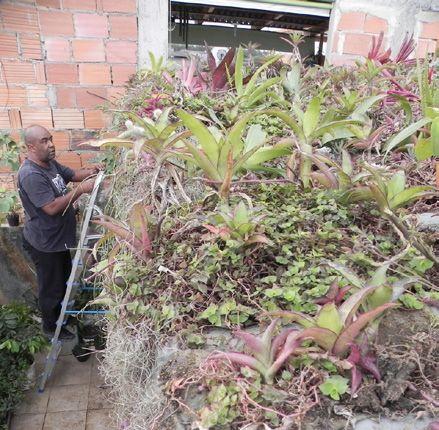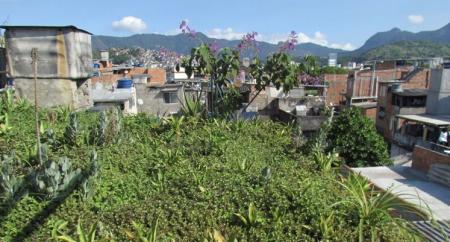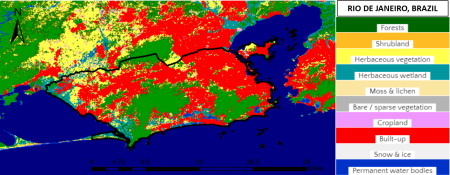
Area characterisation:
Rio de Janeiro is the capital of the Rio de Janeiro state, it lies in the southwestern region of Brazil in the Neotropics region. The city has an area of 1.250 km2 which includes islands and continental waters. The municipality has 32 administrative regions along 159 districts. There are 13,540 inhabitants, and the principal land covers are urban and forest. 19% of the population of the city of Rio de Janeiro, Brazil, nowadays lives in the slums, or informal settlements, experiencing the heat island effect as a result of densely populated areas built without proper thermal insulation and often without green spaces for thermal control. One example of these conditions is Arará: there are no open spaces available for planting trees, and building new green spaces is virtually impossible due to lack of space.
Objective:
Controlling and mitigating the heat island effect in Arará slum, northern Rio de Janeiro, based on the development and monitoring of green roofs, using epiphytes or lithophytes. Given the common uses of cement or metal, tiles required the development of specific techniques and materials to allow for the growth of vegetation while keeping the overall weight low for safety.
Images
Potential impacts/benefits:
The successful performance of the planted species in the green roof translated into an effective decoupling of temperature and thermal insulation. The recorded temperature in the green roof was constant throughout the day and an average 40% lower than that observed in the surrounding regular roofs.
Thus, main impacts of the establishment of green roofs in an informal settlement of Rio de Janeiro were improved well-being in the local communities, reducing the heat island effect, and decreasing the temperature in the slum urbanization. As a result, these actions had an impact on public health reducing the pressure of health issues such as cardiovascular diseases.
Thus, some of the most evident benefits of green roofs in Arará slum are:
- Reducing the storm-water runoff
- Increased well-being
- Changing image of the urban environment
- Increased social interaction
Actions:
Succulents, herbs, and small shrubs were planted on green roofs in order to control and mitigate the heat island effect in Arará slum. Most of them were epiphytes or lithophytes, in other words, plants adapted to the low substrate, high wind, and solar exposure, making them ideal for low maintenance green roofs. Plants growing on the green roof showed a consistent performance, as measured by various physiological parameters, compared to plants of the same species growing on the soil.
Transferability of result:
This pilot project has a great potential for expansion in the slums of Rio de Janeiro and other cities. The implementation strongly depends on the engagement of the local population, together with technical development support from academia. It is advised to use native species to avoid invasive species introduction while promoting the local biodiversity. The performance of these native plants, under such conditions of the green roofs, must therefore be evaluated to promote the use of individual plants for the best thermal control. Other projects could include: non-conventional food plants and other species with local cultural meanings; developing cheap and lightweight combinations of substrate and plant species to cope with the structural constraints that may be found in the slums.
Lessons learnt:
The successful implementation of green roofs in a slum of Rio de Janeiro, especially in the warms tropics, represents a significant improvement in well-being. The temperature decreases by about 20˚C, improving thermal comfort and even making the difference between being exposed to a temperature above or below thresholds of mortality risks. Considering the current scenario of global warming and expansion of slums worldwide, it is clear that well-planned and designed green roofs may represent a feasible solution for improving the well-being of the most vulnerable urban populations.
Organisations:
Prefeitura Municipal do Rio de Janeiro: https://prefeitura.rio
Universidade Federal do Rio de Janeiro: https://ufrj.br/en/
Client:
Arará slum, northern Rio de Janeiro
Design team:
Bruno Rezende Silva
Contacts:
Giuliano Maselli Locosselli
Institute of Botany and University of São Paulo
São Paulo, Brazil
Global goals:
-
3. Good Health and well being
-
10. Reduced inequalities
-
11. Sustainable cities and communities
-
13. Climate action
-
15. Life on land
NBS goals:
- Developing climate change mitigation
- Developing climate change adaptation
- Improving risk management and resilience
- Urban regeneration through nature-based solutions
- Nature-based solutions for improving well-being in urban areas
NBS benefits:
- Developing climate change adaptation; improving risk management and resilience
- Developing climate change mitigation
Publications and reports:
Amaya-Espinel J.D, Hernández-Garcia J. & Cruz-Suárez M.A. 2021. State of the art, good practices and NbS typology in European Union and Latin America cities. Report D2.1 v1.1. European Union’s Horizon 2020 research and innovation programme under grant agreement no. 867564 tinyurl.com/conexus-project.

